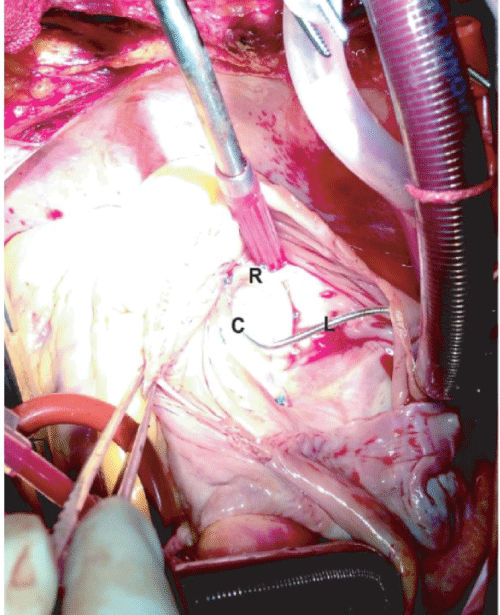International Journal of Clinical Cardiology
Surgical Treatment of Severe Tricuspid Valve Regurgitation Due to Permanent Pacemaker
Wenjian Jiang1-5#, Haiyang Li1-5#, Dong Guo1-5#, Yongqiang Lai1-3* and Hongjia Zhang1-5*
1Department of Cardiac Surgery, Beijing Anzhen Hospital, Capital Medical University, Beijing, China
2Beijing Institute of Heart, Lung and Blood Vessel Diseases, Beijing, China
3The key laboratory of Remodeling-related Cardiovascular Disease, Ministry of Education, Beijing, China
4Beijing Aortic Disease Center, Cardiovascular Surgery Center, Beijing, China
5Beijing Engineering Research Center for Vascular Prostheses, Beijing, China
#These authors contributed equally to this study
*Corresponding author: Hongjia Zhang, M.D and Yongqiang Lai, M.D, Department of Cardiac Surgery, Beijing Anzhen Hospital, Capital Medical University, No.2 Anzhen Street, Beijing 100029, China, E-mail: zhanghongjia722@hotmail.com, yongqianglai@yahoo.com
Int J Clin Cardiol, IJCC-1-009, (Volume 1, Issue 2), Case Report; ISSN: 2378-2951
Received: October 25, 2014 | Accepted: November 21, 2014 | Published: November 24, 2014
Citation: Jiang W, Li H, Guo D, Lai Y, Zhang H (2014) Surgical Treatment of Severe Tricuspid Valve Regurgitation Due to Permanent Pacemaker. Int J Clin Cardiol 1:009. 10.23937/2378-2951/1410009
Copyright: © 2014 Jiang W, et al. This is an open-access article distributed under the terms of the Creative Commons Attribution License, which permits unrestricted use, distribution, and reproduction in any medium, provided the original author and source are credited.
Abstract
A 64-year-old woman, received implantation of a Permanent Pace Maker (PPM) 7 years ago, was referred for severe tricuspid valve regurgitation with a lead impingement of the tricuspid valve leaflets. We fixed the lead to the posterior septal commissure, used 28 # Edwards MC3 ring to annulus form the tricuspid valve ring and then sutured the posterior septal commissure by edge to edge. This patient recovered uneventfully, with only mild tricuspid valve regurgitation by echocardiography after one year of follow-up.
Introduction
The electrode lead implantation of endocardial permanent pacemaker (PPM) should come through the Tricuspid Valve (TV), while the mechanical friction of the pacing lead or secondary to atrioventricular discordance with asynchronous ventricular pacing can cause structural lesions or deformity of the TV by and finally lead to Tricuspid Regurgitation (TR). With the aging of the population and the expanding use of pacemakers and Implantable Cardioverter Defibrillators (ICD) in clinical practice, this complication may be seen more frequently [1].
Case Report
A 64-year-old woman was checked in for discomfort in precordial area. The patient suffered from atrial fibrillation 21 years ago without obvious discomfort and received no regular treatment. Owing to severe atrioventricular block, she received a one-lead permanent pacemaker (PPM) implantation without any co-morbidities on December 6th, 2006. The PPM was Medtronic, Serial BBD163588V, Type 4074. However, after that, she felt discomfort in precordial area and this symptom became worse and worse from 4 years ago. The preoperative echocardiography showed that pacemaker implantation, double atriums enlargement, severe tricuspid regurgitation (reflux size 11.3cm2), mild pulmonary hypertension, mild mitral regurgitation and patent foramen ovale. Coronary angiography showed there was a 90% stenosis in the initial segment of PLA. ECG showed ectopic rhythm, atrial fibrillation and abnormal T waves. So we speculated that the TR may be caused by the lead impingement of the tricuspid valve leaflets. At that time, we have two decisions, one was to remove the former lead and to position an epicardial lead during the same intervention; the other one was to remain the former lead and to do tricuspid valve annuloplasty. Given the patient's bad economic condition and the good state of the former lead, we decided to choose the second plan as the best choice, but we also prepared to change the lead if this procedure failed.
We changed the pacemaker to a fixed pacing 80 beats/min before the operation. After established cardiopulmonary bypass, we used Medtronic Bipolar radiofrequent pen to isolate the pulmonary vein and anastomosed the distal saphenous vein to the PLA. After incised the right atrium, we found that the tricuspid valve leaflets were loosen, tricuspid valve ring was expanded and the lead of PPM significantly affected the contact surface of the valve leaflets, all of which resulted in the tricuspid severe regurgitation. Thus we did tricuspid annuloplasty by 28 # Edwards MC3 ring and fixed the lead of PPM to the posterior septal commissure. Then, we found there seemed to be a reflux in the posterior septal commissure. So, we sutured the posterior septal commissure by edge to edge. After that, there was no reflux and the valve leaflets contacted very well. PFO and the incision of the right atrium were sutured directly and we anastomosed the proximal saphenous vein and the ascending aorta. The postoperative echocardiography showed mild mitral regurgitation and no tricuspid regurgitation. This patient recovered uneventfully, with neither right-sided endocarditis nor lead malfunction. There was only mild tricuspid valve regurgitation after one year of follow-up (Figure 1).
 Figure 1: The picture of tricuspid valve after the plasty. (L: the lead of PPM,
R: 28 # Edwards MC3 ring, C: the posterior septal commissure).
View Figure 1
Figure 1: The picture of tricuspid valve after the plasty. (L: the lead of PPM,
R: 28 # Edwards MC3 ring, C: the posterior septal commissure).
View Figure 1
Discussion
Severe TR can be deleterious to the patient because it raises the central venous pressure by increasing the right sided preload. Chronically, the increase in right sided blood volume can result in an increase in the right atrial pressure leading to a decrease in venous return and low cardiac output [1]. The electrode lead implantation of endocardial permanent pacemaker (PPM) can cause structural lesions of the tricuspid valve such as avulsion or laceration [2-4] and perforation of the tricuspid valve leaflet by its entrapment in the tricuspid apparatus [5]. Finally it would lead to severe Tricuspid Regurgitation (TR). This kind of tricuspid regurgitation is not the same as the common ones. The most common presentation of tricuspid regurgitation is secondary to cardiac valvular pathology (mostly mitral valve disease) on the left side of the heart. As pulmonary hypertension develops leading to right ventricular dilatation, the tricuspid valve annulus will dilate. The circumference of the annulus lengthens primarily along the attachments of the anterior and posterior leaflets. The septal leaflet is fixed between the fiberous trigones, preventing lengthening. As the annular and ventricular dilation progresses, the chordal papillary muscle complex becomes functionally shortened. This combination prevents leaflet apposition, resulting in valvular incompetence [6,7].
However, in this case, severe tricuspid valve regurgitation was caused Permanent Pacemaker (PPM) implantation with a lead impingement of the tricuspid valve leaflets. And owing to the long period after this implantation (about 7 years), the tricuspid valve annulus was also dilated. So firstly we chose to use 28 # Edwards MC3 ring to annulus form the tricuspid valve ring and sutured the posterior septal commissure by edge to edge, which was the same as common tricuspid valve plasty. Beside that, we also fixed the lead to the posterior septal commissure, because we considered that this was the primary factor leading to the TR. We also worried about the right-sided endocarditis and lead malfunction, but given the seven-year good condition of the patient after the implantation of PMM, we decided to choose this procedure. Finally the result of echocardiography after one year of follow-up, which was only mild tricuspid valve regurgitation, suggested that we made a successful choice.
Conclusion
Considering all the things we have discussed above, a safely conclusion should be made that tricuspid annuloplasty with fixing the lead of PPM to the posterior septal commissure is an excellent surgical option for severe TR, which is caused by PPM implantation.
Funding
This study was supported by National Natural Science Foundation of China (NO. 81170283 and NO. 81470580).
References
-
Iskandar SB, Ann Jackson S, Fahrig S, Mechleb BK, Garcia ID (2006) Tricuspid valve malfunction and ventricular pacemaker lead: case report and review of the literature. Echocardiography 23: 692-697.
-
Assayg P, Thuaire C, Benamer H, Sebbah J, Leport C, et al. (1999) Partial rupture of the tricuspid valve after extraction of permanent pacemaker leads: detection by transesophageal echocardiography. Pacing Clin Electrophysiol 22: 971-974.
-
Fishenfeld J, Lamy Y (1972) Laceration of the tricuspid valve by a pacemaker wire. Chest 61: 697-698.
-
Ong LS, Barold SS, Craver WL, Falkoff MD, Heinle RA (1981) Partial avulsion of the tricuspid valve by tined pacing electrode. Am Heart J 102: 798-799.
-
Christie JL, Keelan MH Jr (1986) Tricuspid valve perforation by a permanent pacing lead in a patient with cardiac amyloidosis: case report and brief literature review. Pacing Clin Electrophysiol 9: 124-126.
-
Cohen SR, Sell JE, McIntosh CL, Clark RE (1987) Tricuspid regurgitation in patients with acquired, chronic, pure mitral regurgitation, I: prevalence, diagnosis, and comparison of preoperative clinical and hemodynamic features in patients with and without tricuspid regurgitation. J Thorac Cardiovasc Surg 94: 481.
-
Cohen SR, Sell JE, McIntosh CL, Clark RE (1987) Tricuspid regurgitation in patients with acquired, chronic, pure mitral regurgitation. II. Nonoperative management, tricuspid valve annuloplasty, and tricuspid valve replacement. J Thorac Cardiovasc Surg 94: 488-497.





